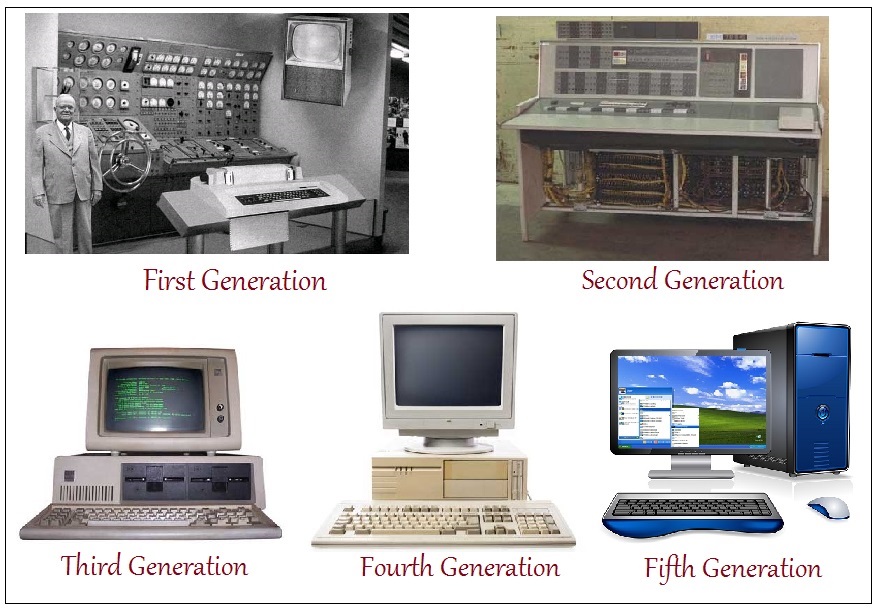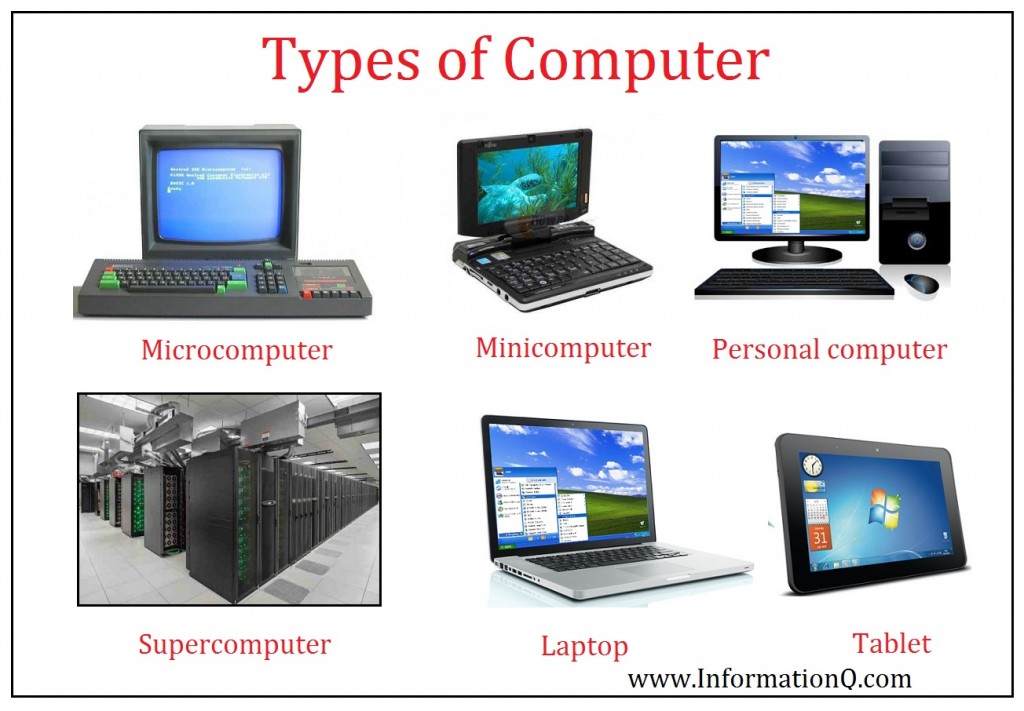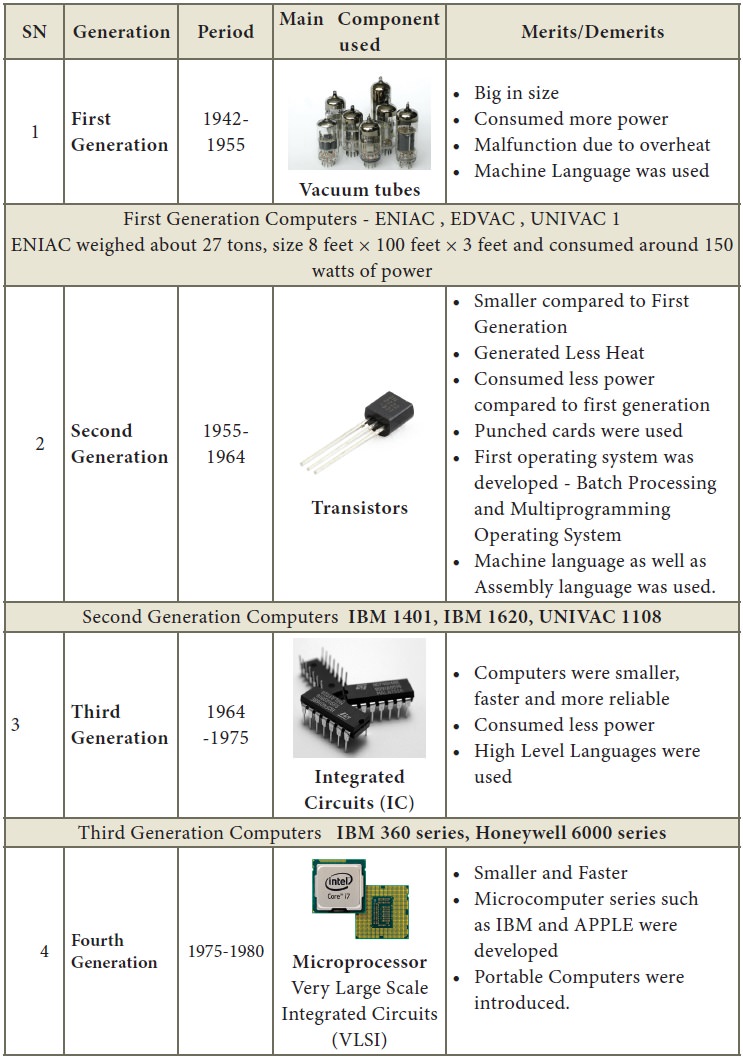Answer 1 of 28. While the third generation is considered by many people to have.

Computer Generations Classified Into Five Types Inforamtionq Com
Main functions of such type include managing customer statistics census and other heavy data in a single device.

. Ideally these machines will be able to respond to their environment using different types of sensors. The Apple II and ENIAC are another example of generations of computers. First generation computers depended on machine language the lowest programming language understood by computers to perform operations 1GL.
Different types of computers have different purposes. Earlier the term generation was used to differentiate between different hardware technologies. The computers of first-generation were managed to use in different fields like weather forecasting solving mathematical problems energy tasks also in space research military and other scientific tasks.
The major four types of Computer Generations. Computer Generations classified into five types such as following. The major types of computers are.
Each generation of computer is characterized by a major technological development that fundamentally changed the way computers operate resulting in increasingly smaller cheaper more powerful and more efficient and reliable devices. The various generations of computers an listed below. In the first generation of computers the first computer of the world named ENIAC Electronic Numerical Integrator and Computer was discovered by John.
Nearly all computers since the mid to late 1960s have utilized ICs. These together form the. For instance the two different generations of computer processors are the Intel Pentium and Intel Pentium II are both IBM compatible processor.
Learn about the 6 different types of computers and you may find some of them are familiar. Vacuum Tubes 1940-1956 The first computer systems used vacuum tubes for circuitry and magnetic drums for memory and were often enormous taking up entire rooms. Nowadays generation includes both hardware and software which together make up an entire computer system.
First generation computers relied on machine language the lowest-level programming language understood by computers to perform operations and they could only solve one problem at a time. Language Assembly Language and High level languages like FORTRAN COBOLBASIC. Transistors 1956-1963 The world would see transistors replace vacuum tubes in the second generation of computers.
Initially the generation term was used to distinguish between varying hardware technologies. It is usually used to do. Try to create a computer with a real IQ with the.
Generation in computer terminology is a change in technology a computer iswas being used. Size Smaller than first generation Computers. Cost cost Slightly lower than first generation.
The UNIVAC and ENIAC computers are examples of first-generation. This period can be divided into five distinct phases known as generations of computers. As of 2020 there are five generations of the computer.
Speed Relatively fast as compared to first generation thousand instructions per second. Review each of the generations below for more information and examples of computers and technology that fall into each generation. One of types of computers is supercomputer.
It is a computer that is at the front-line of current processing capacity particularly speed of calculation. For example the system used at Trading companies. Examples ENIAC UNIVAC1 IBM 650 IBM 701 etc.
Each generation of computer is designed based on a new technological development resulting in better cheaper and. Some of the computers occupying large buildings those can connect huge number of computers. Explain Different Types Of Computer Hardware Computer Computer Hardware What Is Computer The system software provides the platform for users to install and run application software and its made up of multiple programs needed to run a computer.
I First Generation 1946-1954. The main characteristics of first generation of computers 1940s-1950s Power consume a lot of electricity and generate a lot of heat. Generations of Computer The computer has evolved from a large-sized simple calculating machine to a smaller but much more powerful machine.
First generation 1940 - 1956 Second generation 1956 - 1963 Third generation 1964 - 1971 Fourth generation 1972 - 2010 Fifth generation 2010 to present. Mainframe Computer Computers used by large Organisations to manage bulk data are called Mainframe computers. Input was based on punched cards and paper tape and output was displayed on printouts.
Using ICs in computers helped reduce the size of computers even more compared to second-generation computers as well as make them faster. The evolution of computer to the current state is defined in terms of the generations of computer. Inputoutput devices punched cards and paper tape.
Second generation of computer - second generation computers used transistor instead of vaccum tube. However these days generation can be used to refer to both software and hardware. Scientists are working to make this a reality.
Speed and size very slow and very large in size often taking up entire room. The present day computer has undergone rapid change during the last fifty years. This term refers to the change that a computer goes through.
There are five computer generations known till date. The term generation means that the new components and computers are released with the latest technology. For example Smartphones iPads etc.
A Computer Characteristics Capabilities. First generation of computer - first generation computer. The third generation of computers introduced the use of IC Integrated Circuits in computers.
In 1946 there was no best way of storing. In the field of electronics and technology generation is computer terminology.

Computer Generations Classified Into Five Types Inforamtionq Com

Generations Of Computers And Their Characteristics Vidyagyaan


0 Comments